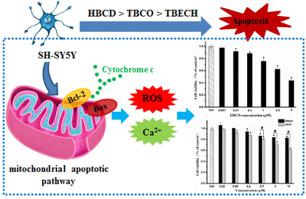Science of the Total Environment ( IF 8.2 ) Pub Date : 2020-06-05 , DOI: 10.1016/j.scitotenv.2020.139650 Xiaoli Shi 1 , Bei Wen 1 , Honglin Huang 2 , Shuzhen Zhang 1

|
With the listing of the of cycloaliphatic brominated flame retardants (CBFR) hexabromocyclododecane (HBCD) as a persistent organic pollutant (POP) by the Stockholm Convention, much attention has been paid to the environmental behaviors and biological effects of HBCD, as well as its potential alternatives, such as 1,2-dibromo-4-(1,2-dibromoethyl) cyclohexane (TBECH) and 1,2,5,6-tetrabromocyclooctane (TBCO). In this study, the neurotoxicity of HBCD, TBECH, and TBCO in human SH-SY5Y cells were compared. The results showed that HBCD, TBECH, and TBCO induced cytotoxicity, including dose–dependent cell viability decreases, cell membrane permeability increases, cytoskeleton development damage, and apoptosis induction, with the cytotoxicity in the order of HBCD > TBCO > TBECH. The expression levels of apoptotic proteins (caspase-3, Bax, caspase-9, Bcl-2, and cytochrome c (Cyt c)) followed the same order, which indicated that mitochondrial apoptotic pathway may be one of the mechanisms responsible for their neurotoxicity. In order to study the mechanisms of cytotoxicity, CBFRs-induced reactive oxygen species (ROS) and the intracellular calcium levels were determined. The ROS levels were significantly elevated for three CBFRs treatment, suggesting that oxidative stress contributes to their cytotoxicity. The intracellular calcium concentrations were significantly enhanced for HBCD and TBCO treatment, but not for TBECH, indicating that in addition to ROS, cytotoxicity of HBCD and TBCO may follow Ca2+-mediated apoptotic pathway. This study first compared the neurotoxicity of different CBFRs, providing valuable information for their risk assessment.
中文翻译:

六溴环十二烷,1,2-二溴-4-(1,2-二溴乙基)环己烷和1,2,5,6-四溴环辛烷在人SH-SY5Y神经母细胞瘤细胞中的细胞毒性。
随着《斯德哥尔摩公约》将脂环族溴化阻燃剂(CBFR)六溴环十二烷(HBCD)列为持久性有机污染物(POP),人们对HBCD的环境行为和生物效应及其潜在潜力给予了极大关注。替代品,例如1,2-二溴-4-(1,2-二溴乙基)环己烷(TBECH)和1,2,5,6-四溴环辛烷(TBCO)。在这项研究中,比较了HBCD,TBECH和TBCO对人SH-SY5Y细胞的神经毒性。结果表明,HBCD,TBECH和TBCO诱导的细胞毒性包括剂量依赖性细胞生存力降低,细胞膜通透性增加,细胞骨架发育损伤和凋亡诱导,其细胞毒性的顺序为HBCD> TBCO> TBECH。凋亡蛋白(caspase-3,Bax,caspase-9,c(Cyt c))遵循相同的顺序,这表明线粒体凋亡途径可能是造成其神经毒性的机制之一。为了研究细胞毒性的机制,测定了CBFRs诱导的活性氧(ROS)和细胞内钙水平。三种CBFRs处理的ROS水平均显着升高,表明氧化应激有助于其细胞毒性。对于HBCD和TBCO处理,细胞内钙浓度显着增加,但对于TBECH则没有,表明除ROS外,HBCD和TBCO的细胞毒性可能遵循Ca 2+介导的凋亡途径。这项研究首先比较了不同CBFR的神经毒性,为其风险评估提供了有价值的信息。

































 京公网安备 11010802027423号
京公网安备 11010802027423号